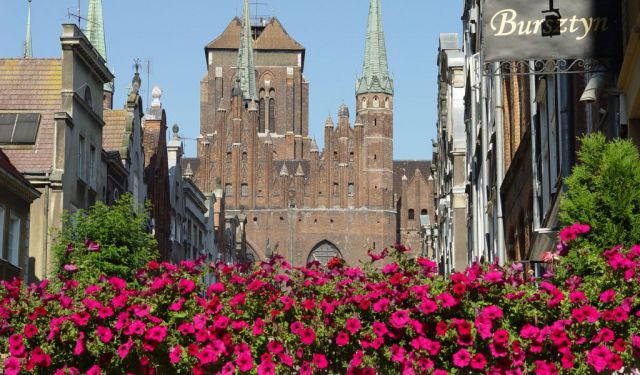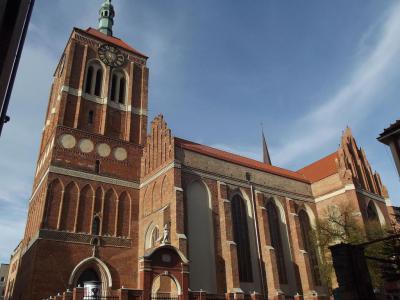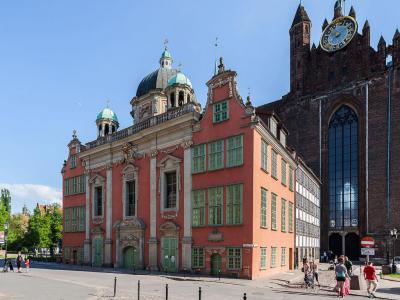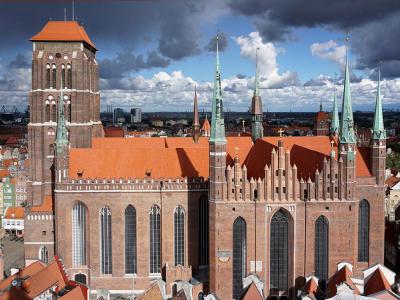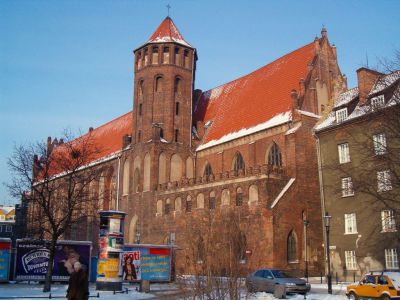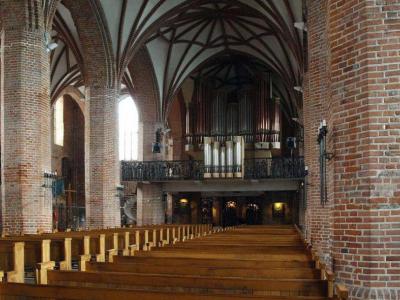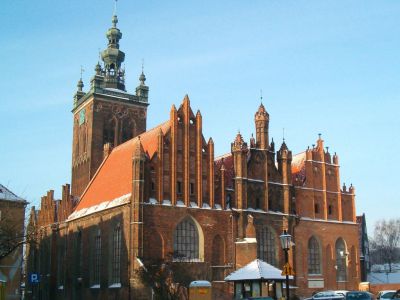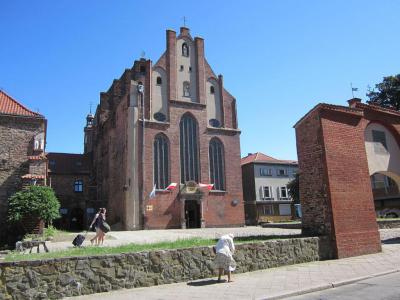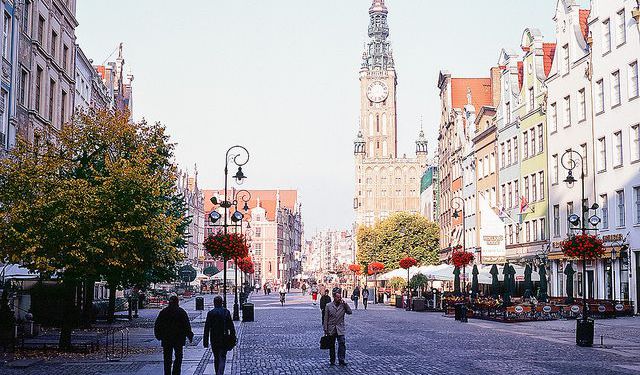Gdansk's Historical Churches Tour (Self Guided), Gdansk
Gdansk has a long history of Catholicism, hence the abundance of spectacular churches here. Let's delve into some of the most impressive temples that grace the cityscape and see what they are.
Saint John's Church, a Gothic masterpiece, stands tall in the heart of Gdansk. It dates back to the 14th century and features impressive brickwork and intricate details. Its towering spire is a symbol of the city and offers panoramic views of Gdansk's skyline.
The Royal Chapel, situated within the Gdansk Castle, is a hidden gem. Built in the late 17th century, this Baroque chapel showcases ornate decorations, serving as a testament to Poland's royal history.
Saint Mary's Church, a colossal brick Gothic structure, is one of the largest in Europe. Its interior boasts stunning stained glass windows and an astronomical clock. The soaring tower provides a captivating view of the city and the Baltic Sea.
Saint Nicholas' Church is the place where many elements reveal a close connection between Poland and other cultures. One of its most interesting objects is the Hodegetria, an icon of “The Guiding Madonna”.
Saint Bridget's Church, a charming Gothic sanctuary, is known for its tranquil atmosphere and beautiful wooden altarpiece. Meanwhile, Saint Catherine's Church, another Gothic gem, showcases magnificent wood carvings inside.
Finally, Saint Joseph's Church, a Baroque masterpiece, stands out with its imposing exterior reflecting the grandeur of the era it was built in.
Apart from being architectural marvels, Gdansk's historical churches are also repositories of the city's eventful history and cultural heritage. Exploring these sacred sites provides a glimpse into the past and a deeper appreciation for Gdansk's unique charm. Whether you're a history enthusiast, an architecture aficionado, or simply seeking spiritual solace, these churches will interest you all the same.
Saint John's Church, a Gothic masterpiece, stands tall in the heart of Gdansk. It dates back to the 14th century and features impressive brickwork and intricate details. Its towering spire is a symbol of the city and offers panoramic views of Gdansk's skyline.
The Royal Chapel, situated within the Gdansk Castle, is a hidden gem. Built in the late 17th century, this Baroque chapel showcases ornate decorations, serving as a testament to Poland's royal history.
Saint Mary's Church, a colossal brick Gothic structure, is one of the largest in Europe. Its interior boasts stunning stained glass windows and an astronomical clock. The soaring tower provides a captivating view of the city and the Baltic Sea.
Saint Nicholas' Church is the place where many elements reveal a close connection between Poland and other cultures. One of its most interesting objects is the Hodegetria, an icon of “The Guiding Madonna”.
Saint Bridget's Church, a charming Gothic sanctuary, is known for its tranquil atmosphere and beautiful wooden altarpiece. Meanwhile, Saint Catherine's Church, another Gothic gem, showcases magnificent wood carvings inside.
Finally, Saint Joseph's Church, a Baroque masterpiece, stands out with its imposing exterior reflecting the grandeur of the era it was built in.
Apart from being architectural marvels, Gdansk's historical churches are also repositories of the city's eventful history and cultural heritage. Exploring these sacred sites provides a glimpse into the past and a deeper appreciation for Gdansk's unique charm. Whether you're a history enthusiast, an architecture aficionado, or simply seeking spiritual solace, these churches will interest you all the same.
How it works: Download the app "GPSmyCity: Walks in 1K+ Cities" from Apple App Store or Google Play Store to your mobile phone or tablet. The app turns your mobile device into a personal tour guide and its built-in GPS navigation functions guide you from one tour stop to next. The app works offline, so no data plan is needed when traveling abroad.
Gdansk's Historical Churches Tour Map
Guide Name: Gdansk's Historical Churches Tour
Guide Location: Poland » Gdansk (See other walking tours in Gdansk)
Guide Type: Self-guided Walking Tour (Sightseeing)
# of Attractions: 7
Tour Duration: 1 Hour(s)
Travel Distance: 1.6 Km or 1 Miles
Author: vickyc
Sight(s) Featured in This Guide:
Guide Location: Poland » Gdansk (See other walking tours in Gdansk)
Guide Type: Self-guided Walking Tour (Sightseeing)
# of Attractions: 7
Tour Duration: 1 Hour(s)
Travel Distance: 1.6 Km or 1 Miles
Author: vickyc
Sight(s) Featured in This Guide:
- St. John's Church
- The Royal Chapel
- St. Mary's Church
- St. Nicholas' Church
- St. Bridget's Church
- St. Catherine's Church
- St. Joseph's Church
1) St. John's Church
Saint John's Church, constructed in the 14th century, is a significant example of Gothic ecclesiastical architecture in Gdańsk. The church was heavily damaged in World War II and underwent reconstruction in the 1950s and 1980s. Initially serving as a religious site, the church's function transformed over the years. After the war, it remained unused until 1991 when the Gdansk Archdiocese of the Roman Catholic Church acquired it from the State Treasury.
In 1995, a pivotal change occurred when The Baltic Sea Cultural Centre, through an agreement with the Archdiocese of Gdansk, took over the administration of Saint John's Church. This led to the establishment of the Renovation of Saint John’s Office, initiating a series of works that revitalized the church. Today, Saint John's Church is not only a historic monument but also a bustling International Culture Centre.
The church's architectural design is quintessentially Gothic, characteristic of Gdańsk's ecclesiastical structures built during the 14th and 15th centuries. It boasts a hall layout with a transept and is noted for its massive structure, including interior buttresses and a tall tower in the western section. Historically, it was the second parish church in Main Town, rivaling Saint Mary's Church in its lavish interior decorations.
Despite the damages it suffered, Saint John's Church retains many original artworks. Among these is the stone main altar, a masterpiece crafted by Abraham van den Block, showcasing the artistic richness of the church.
As a contemporary cultural hub, Saint John's Church now hosts a variety of cultural events, such as exhibitions, concerts, festivals, film screenings, and more. The integration of high-tech equipment allows for a broad range of cultural activities, enhancing the visitor experience and blending tradition with modernity.
In 1995, a pivotal change occurred when The Baltic Sea Cultural Centre, through an agreement with the Archdiocese of Gdansk, took over the administration of Saint John's Church. This led to the establishment of the Renovation of Saint John’s Office, initiating a series of works that revitalized the church. Today, Saint John's Church is not only a historic monument but also a bustling International Culture Centre.
The church's architectural design is quintessentially Gothic, characteristic of Gdańsk's ecclesiastical structures built during the 14th and 15th centuries. It boasts a hall layout with a transept and is noted for its massive structure, including interior buttresses and a tall tower in the western section. Historically, it was the second parish church in Main Town, rivaling Saint Mary's Church in its lavish interior decorations.
Despite the damages it suffered, Saint John's Church retains many original artworks. Among these is the stone main altar, a masterpiece crafted by Abraham van den Block, showcasing the artistic richness of the church.
As a contemporary cultural hub, Saint John's Church now hosts a variety of cultural events, such as exhibitions, concerts, festivals, film screenings, and more. The integration of high-tech equipment allows for a broad range of cultural activities, enhancing the visitor experience and blending tradition with modernity.
2) The Royal Chapel
The Royal Chapel in Gdansk is an architectural and historical landmark located on the street of the Holy Spirit, adjacent to the Basilica of the Virgin Mary. This chapel, unique for its Baroque style, was founded in part by Polish King Jan III Sobieski with contributions from Primate Andrzej Olszewski. Constructed between 1678 and 1681, the Royal Chapel's inception was intertwined with the resolution of a longstanding religious conflict in Gdansk.
Before the Royal Chapel was established, both Lutherans and Catholics shared the Basilica of the Holy Virgin Mary for their religious services. Catholics used the main altar, and Protestants used the altar of Saint Nicholas. However, in the late 16th century, Lutherans expelled Catholics from the basilica, forcing Catholics to use the Plebania of the Holy Mother of God, a parish house adorned with the Ferber family's coat of arms and built between 1517 and 1518. The Royal Chapel was created as a solution, providing Gdansk Catholics with their dedicated place of worship.
The chapel's construction involved the demolition of five houses on Saint Spirit Street. It was designed by architect Tillmann von Gameren, while Andreas Schluter Jr. was responsible for the interior work. The interior of the chapel was beautifully adorned with stucco flower garlands, the emblem of Poland, the coat of arms of the Chase, and the symbol of the Sobieski royal family.
Despite its historical significance, the Royal Chapel suffered partial destruction during the tumultuous events of the 20th century. It sustained damage to its western wall due to a shell, and much of its church furniture and utensils were irretrievably lost. However, during restoration efforts, it was discovered that the valuable 19th-century paintings on the vault were remarkably well-preserved. The chapel was successfully restored and reopened to the public in 1948, showcasing its original grandeur and continuing to serve as a testament to the rich religious and cultural history of Gdansk.
Before the Royal Chapel was established, both Lutherans and Catholics shared the Basilica of the Holy Virgin Mary for their religious services. Catholics used the main altar, and Protestants used the altar of Saint Nicholas. However, in the late 16th century, Lutherans expelled Catholics from the basilica, forcing Catholics to use the Plebania of the Holy Mother of God, a parish house adorned with the Ferber family's coat of arms and built between 1517 and 1518. The Royal Chapel was created as a solution, providing Gdansk Catholics with their dedicated place of worship.
The chapel's construction involved the demolition of five houses on Saint Spirit Street. It was designed by architect Tillmann von Gameren, while Andreas Schluter Jr. was responsible for the interior work. The interior of the chapel was beautifully adorned with stucco flower garlands, the emblem of Poland, the coat of arms of the Chase, and the symbol of the Sobieski royal family.
Despite its historical significance, the Royal Chapel suffered partial destruction during the tumultuous events of the 20th century. It sustained damage to its western wall due to a shell, and much of its church furniture and utensils were irretrievably lost. However, during restoration efforts, it was discovered that the valuable 19th-century paintings on the vault were remarkably well-preserved. The chapel was successfully restored and reopened to the public in 1948, showcasing its original grandeur and continuing to serve as a testament to the rich religious and cultural history of Gdansk.
3) St. Mary's Church (must see)
The formal name for Saint Mary's is Basilica of the Assumption of the Blessed Virgin Mary. Between 1536 and 1572 the church had been used jointly by Catholics and Lutherans. From the late 16th century until 1945 it was the second largest Lutheran church in the world. The church has been Catholic since 1945.
The church is an aisled hall church with transept. It is 346 feet long. The nave is 217 feet wide. It can hold up to 25,000 souls at one time. The first stone for the church was laid in 1343. It so happened to be the feast of the Assumption. The original basilica had six bays and a low turret. It was finished in 1360.
The current building was started in 1379 by architect Heinrich Ungeradin. The primary building material was brick. This was common to Gothic style churches of Flanders and the Netherlands. The church was finished and the tower raised by 1466. The nave core and vaulting was done by 1500, just in time for the Protestant Reformation.
No serious structural changes were carried out under Lutheran auspices. There was heavy damage to the church during World War II. Restoration began again in 1946. The church is frequently called the "Crown of Gdansk." It is considered to be the largest brick temple in Europe and the finest among the towns of the old Hanseatic League.
Inside the church is a wealth of medieval artifacts. There is a stone Pieta from 1410, and a copy of The Last Judgement made in 1472 by Hans Memling. An astronomical clock made in 1467 by Hans Duringer is here. The main altar was built in 1510-1517. The church does hold services. It is open to visitors year-round.
The church is an aisled hall church with transept. It is 346 feet long. The nave is 217 feet wide. It can hold up to 25,000 souls at one time. The first stone for the church was laid in 1343. It so happened to be the feast of the Assumption. The original basilica had six bays and a low turret. It was finished in 1360.
The current building was started in 1379 by architect Heinrich Ungeradin. The primary building material was brick. This was common to Gothic style churches of Flanders and the Netherlands. The church was finished and the tower raised by 1466. The nave core and vaulting was done by 1500, just in time for the Protestant Reformation.
No serious structural changes were carried out under Lutheran auspices. There was heavy damage to the church during World War II. Restoration began again in 1946. The church is frequently called the "Crown of Gdansk." It is considered to be the largest brick temple in Europe and the finest among the towns of the old Hanseatic League.
Inside the church is a wealth of medieval artifacts. There is a stone Pieta from 1410, and a copy of The Last Judgement made in 1472 by Hans Memling. An astronomical clock made in 1467 by Hans Duringer is here. The main altar was built in 1510-1517. The church does hold services. It is open to visitors year-round.
4) St. Nicholas' Church
Saint Nicholas' Church, located in the historic city of Gdańsk, is a testament to the rich architectural and cultural heritage of the region. Its history dates back to the 12th century, making it one of the oldest churches in Gdańsk. Adjacent to this venerable basilica is a Dominican monastery, which continues to exist to this day, further underscoring the historical and religious significance of the site.
Despite its considerable age, Saint Nicholas Church has admirably withstood the passage of time, particularly during the turbulent periods of history. Remarkably, it survived the widespread destruction of World War II that heavily impacted much of Gdańsk. This survival may be attributed to its robust construction, fortuitous location, or a combination of both factors.
Architecturally, the church serves as an excellent example of Gothic ecclesiastical design, a style commonly seen in religious buildings of its era. However, the interior of Saint Nicholas Church offers a unique amalgamation of various artistic styles, seamlessly blending elements of Gothic, Renaissance, Baroque, and Rococo designs. This eclectic fusion not only demonstrates the evolution of artistic preferences over centuries but also mirrors the diverse influences that have shaped the culture and aesthetics of the region.
Among the most treasured possessions of the church are its artistic and historical artifacts. The Renaissance main altar stands out for its intricate design and historical significance. It is complemented by the Gothic Pietà, a moving depiction of Mary cradling the deceased Christ, a recurring theme in Christian art.
The church also features a 15th-century painting of the Mother of God with the Child, alongside a crucifix from the chancel beam and epitaphs of Pomeranian nobility, all adding to the rich narrative of the region's history and the church's significance.
Despite its considerable age, Saint Nicholas Church has admirably withstood the passage of time, particularly during the turbulent periods of history. Remarkably, it survived the widespread destruction of World War II that heavily impacted much of Gdańsk. This survival may be attributed to its robust construction, fortuitous location, or a combination of both factors.
Architecturally, the church serves as an excellent example of Gothic ecclesiastical design, a style commonly seen in religious buildings of its era. However, the interior of Saint Nicholas Church offers a unique amalgamation of various artistic styles, seamlessly blending elements of Gothic, Renaissance, Baroque, and Rococo designs. This eclectic fusion not only demonstrates the evolution of artistic preferences over centuries but also mirrors the diverse influences that have shaped the culture and aesthetics of the region.
Among the most treasured possessions of the church are its artistic and historical artifacts. The Renaissance main altar stands out for its intricate design and historical significance. It is complemented by the Gothic Pietà, a moving depiction of Mary cradling the deceased Christ, a recurring theme in Christian art.
The church also features a 15th-century painting of the Mother of God with the Child, alongside a crucifix from the chancel beam and epitaphs of Pomeranian nobility, all adding to the rich narrative of the region's history and the church's significance.
5) St. Bridget's Church
Saint Bridget's Church in Gdansk is an important historical and cultural site deeply connected to Polish history and the Catholic religion. First built in the late 14th century for Saint Bridget's Order followers, the church has a significant past. It was almost entirely destroyed during World War II and was reconstructed in 1973 using its original 1394-1420 designs. This rebuild maintains the church's original architectural style and its historical importance.
The church's standout feature is the 'Amber Altar', a continuing project that honors Divine Providence, celebrates Pope John Paul II's papacy, and acknowledges Poland's regained independence. This altar is a religious symbol and an artistic masterpiece, displaying the Blessed Virgin Mary, painted by Father Franciszek Znaniecki, influenced by the December 1970 workers' massacre. It includes figures like Saint Bridget of Sweden, Saint Elizabeth Hesselblad, Pope Saint John Paul II, and Cardinal Stefan Wyszynski, showing the blend of Polish patriotism and Catholic faith. The altar also has an amber monstrance with relics of Pope Saint John Paul II and Blessed Jerzy Popieluszko, adding to its historical and religious value.
The church also features memorials to various historical events, like the Katyń massacre and tributes to Solidarity (Solidarność), a broad anti-authoritarian social movement, showing the strong link between the Catholic Church and Polish nationalism. One memorial is for Father Jerzy Popieluszko, a Solidarity chaplain killed by secret police in 1984.
In 2010, renovation works uncovered a hidden crypt with human remains, believed to be from the early 17th century. Now open to the public, this crypt contains Saint Bridget of Sweden's relics and some of the found skulls, adding more to the church's rich history.
Finally, the church's recognition as a Lesser Basilica in 1991 by Pope John Paul II and his statue outside highlight its religious significance and its ties to the broader Catholic community. Saint Bridget's Church is more than a place of worship; it's a symbol of Polish history, faith, and endurance.
The church's standout feature is the 'Amber Altar', a continuing project that honors Divine Providence, celebrates Pope John Paul II's papacy, and acknowledges Poland's regained independence. This altar is a religious symbol and an artistic masterpiece, displaying the Blessed Virgin Mary, painted by Father Franciszek Znaniecki, influenced by the December 1970 workers' massacre. It includes figures like Saint Bridget of Sweden, Saint Elizabeth Hesselblad, Pope Saint John Paul II, and Cardinal Stefan Wyszynski, showing the blend of Polish patriotism and Catholic faith. The altar also has an amber monstrance with relics of Pope Saint John Paul II and Blessed Jerzy Popieluszko, adding to its historical and religious value.
The church also features memorials to various historical events, like the Katyń massacre and tributes to Solidarity (Solidarność), a broad anti-authoritarian social movement, showing the strong link between the Catholic Church and Polish nationalism. One memorial is for Father Jerzy Popieluszko, a Solidarity chaplain killed by secret police in 1984.
In 2010, renovation works uncovered a hidden crypt with human remains, believed to be from the early 17th century. Now open to the public, this crypt contains Saint Bridget of Sweden's relics and some of the found skulls, adding more to the church's rich history.
Finally, the church's recognition as a Lesser Basilica in 1991 by Pope John Paul II and his statue outside highlight its religious significance and its ties to the broader Catholic community. Saint Bridget's Church is more than a place of worship; it's a symbol of Polish history, faith, and endurance.
6) St. Catherine's Church
Saint Catherine's Church in Gdańsk is the oldest church in the city, with its origins tracing back to the 1220s. The church's architecture is primarily Gothic in style, featuring chapels, a high gable roof, a square floor plan, and vaults, all of which contribute to its historical and architectural significance. Over the centuries, the church underwent numerous renovations and additions to achieve its current form.
For centuries, Saint Catherine's Church played a pivotal role in the religious life of Gdańsk. From 1545 until the end of World War II in 1945, it served as a Protestant church. Post-World War II, it was reinstated as a Catholic church, marking a significant shift in its religious affiliation.
The church is not only a place of worship but also a site of historical importance. It is the final resting place of the renowned 17th-century astronomer Johannes Hevelius, who also served as the church's administrator. His dedication to the church is commemorated with his tomb located at the rear behind the altar, complete with an epitaph funded by his grandson almost a century after Hevelius' death.
Apart from its religious and historical significance, Saint Catherine's Church is also notable for its contributions to culture and science. Since 2011, it houses the world's first pulsar clock, a remarkable feat in the field of astronomy. Additionally, the church is home to the Museum of Turret Clocks, a part of the Museum of Gdańsk, showcasing the historical evolution of timekeeping. The church's attic was once utilized as an art gallery from 2000 to 2006, further emphasizing its cultural value.
The church's standout feature is its 76-meter Baroque tower with a 49-bell carillon that has chimed every hour since 1939 to commemorate WWII.
For centuries, Saint Catherine's Church played a pivotal role in the religious life of Gdańsk. From 1545 until the end of World War II in 1945, it served as a Protestant church. Post-World War II, it was reinstated as a Catholic church, marking a significant shift in its religious affiliation.
The church is not only a place of worship but also a site of historical importance. It is the final resting place of the renowned 17th-century astronomer Johannes Hevelius, who also served as the church's administrator. His dedication to the church is commemorated with his tomb located at the rear behind the altar, complete with an epitaph funded by his grandson almost a century after Hevelius' death.
Apart from its religious and historical significance, Saint Catherine's Church is also notable for its contributions to culture and science. Since 2011, it houses the world's first pulsar clock, a remarkable feat in the field of astronomy. Additionally, the church is home to the Museum of Turret Clocks, a part of the Museum of Gdańsk, showcasing the historical evolution of timekeeping. The church's attic was once utilized as an art gallery from 2000 to 2006, further emphasizing its cultural value.
The church's standout feature is its 76-meter Baroque tower with a 49-bell carillon that has chimed every hour since 1939 to commemorate WWII.
7) St. Joseph's Church
Saint Joseph's Church in Gdańsk is a historic site that reflects the evolution of religious architecture and the shifting fortunes of the city. The church's origins trace back to a hospital and Saint George’s chapel. In 1467, the Carmelite Order received the area of Saint George’s Leper Hospital, initiating the church's construction.
Initially, the church was ambitiously planned as a hall structure with three aisles and a larger chancel. However, financial constraints led to a more modest execution. Only the northern aisle and part of the nave were completed. The chancel, finalizing at 31 x 15 meters, boasts a stellar net vault and a late Gothic gable, showcasing the architectural style of the period.
The construction began with a grand portal. Due to limited funds, the portal now stands at a distance from the main building, a unique feature resulting from the altered construction plans. By 1623, only one of the three planned aisles was constructed, accompanied by a presbytery and a chapel.
Tragedy struck in 1663 when the church burned down. It was subsequently rebuilt and transformed style, adopting Baroque elements in its furnishings. In 1840, following the displacement of the Carmelite monks, the church was repurposed into a parish, marking a new chapter in its history.
Adjacent to the chancel, a sacristy was added, likely incorporating parts of the older Saint George chapel. The monastery complex surrounding the church included a cloister, refectories, and various economic buildings, forming a comprehensive religious site.
Saint Joseph's Church stands today as a testament to historical resilience and architectural adaptation. It embodies the varied history of Gdańsk and its religious communities, encapsulating centuries of change and continuity in its walls.
Initially, the church was ambitiously planned as a hall structure with three aisles and a larger chancel. However, financial constraints led to a more modest execution. Only the northern aisle and part of the nave were completed. The chancel, finalizing at 31 x 15 meters, boasts a stellar net vault and a late Gothic gable, showcasing the architectural style of the period.
The construction began with a grand portal. Due to limited funds, the portal now stands at a distance from the main building, a unique feature resulting from the altered construction plans. By 1623, only one of the three planned aisles was constructed, accompanied by a presbytery and a chapel.
Tragedy struck in 1663 when the church burned down. It was subsequently rebuilt and transformed style, adopting Baroque elements in its furnishings. In 1840, following the displacement of the Carmelite monks, the church was repurposed into a parish, marking a new chapter in its history.
Adjacent to the chancel, a sacristy was added, likely incorporating parts of the older Saint George chapel. The monastery complex surrounding the church included a cloister, refectories, and various economic buildings, forming a comprehensive religious site.
Saint Joseph's Church stands today as a testament to historical resilience and architectural adaptation. It embodies the varied history of Gdańsk and its religious communities, encapsulating centuries of change and continuity in its walls.
Walking Tours in Gdansk, Poland
Create Your Own Walk in Gdansk
Creating your own self-guided walk in Gdansk is easy and fun. Choose the city attractions that you want to see and a walk route map will be created just for you. You can even set your hotel as the start point of the walk.
Gdansk Introduction Walking Tour
The most probable source for the name, "Gdansk" seems to be "Gdania", the ancient name of the river Motlawa. Gdansk began with agriculture and fishing and trade with Pomerania in the 9th century. It was annexed by Mieszko, Duke of Poland, in 975.
The center of town was the Long Market, with its craftsmen. German merchant settlements grew by St Nicholas Church. Gdansk joined... view more
Tour Duration: 2 Hour(s)
Travel Distance: 2.2 Km or 1.4 Miles
The center of town was the Long Market, with its craftsmen. German merchant settlements grew by St Nicholas Church. Gdansk joined... view more
Tour Duration: 2 Hour(s)
Travel Distance: 2.2 Km or 1.4 Miles
Solidarity Union Walking Tour
For decades, the word 'Solidarity' (Polish: Solidarność) has been synonymous with the city of Gdansk. The peaceful Solidarity revolution, started here in the August of 1980, marked the outset of the fall of communism not only in Poland but also throughout Eastern Europe.
Stemmed from the country's first free labor union born out of strikes at the Lenin Shipyard (now the Gdansk... view more
Tour Duration: 1 Hour(s)
Travel Distance: 0.8 Km or 0.5 Miles
Stemmed from the country's first free labor union born out of strikes at the Lenin Shipyard (now the Gdansk... view more
Tour Duration: 1 Hour(s)
Travel Distance: 0.8 Km or 0.5 Miles
The Most Popular Cities
/ view all
